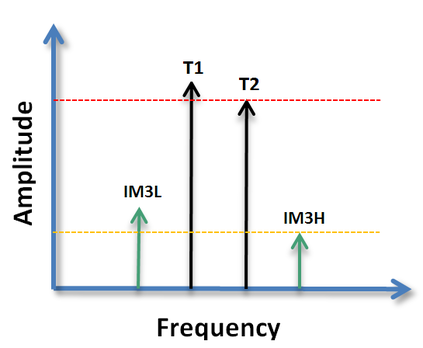OFDM and 3rd order distortion: CrossmodulationOFDM is used in a number of communication and networking standards, including LTE, Wi-Fi, DOCSIS cable modems, MOCA home networking etc. As OFDM typically have a large number of carriers, the impact of 3rd order distortion gets a bit more complicated to evaluate as the number of distortion product combinations are very high. This calculator and article specifically addresses the distortion generated from 3 tones, which is the basis for determining the impact of a multicarrier OFDM signal.
For article, derivation and calculator, click the button below! |
Third order intercept point with unequal tonesIP3 (3rd order intercept point) is a theoretical figure of merit describing the 3rd order distortion performance of a circuit. Often it is assumed that the tones are at the exact same level and the IM products are identical. In reality, this is typically not the case.
Third order distortion causes multiple unwanted products. The most prominent during a two tone test would be the intermodulation products at 2f1-f2, 2f2-f1 and third harmonics at 3f1 and 3f2. The most bothersome in a relative narrowband system would be the intermodulation products, as they often appear in band. For calculator and derivation of the IP3 and IM3 when the tones and/or IM products are uneven, click below. |
MER impact from clock jitterModulation Error Ratio (MER) is a measure of the ratio between the magnitude of an actual constellation point to the magnitude of the error vector from the ideal point in a phase modulated system such as QPSK, 8-PSK, n-QAM, etc. MER is typically calculated in dB, averaged over multiple symbols. It is similar to SNR, but takes into account any impairments to your modulation accuracy, not only white noise. As a result, when the error increases, the MER will decrease.
|




